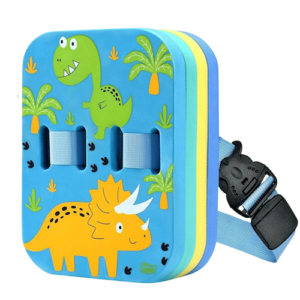As a parent, ensuring your child’s safety in the water is a top priority. You’ve likely seen kids bobbing up and down in their lifejackets or puddle jumpers at the pool. While these devices offer some level of safety, they might not be the best choice for teaching your child how to swim. Enter the swimming backpack, a tool designed to help children learn to swim and gain confidence in the water. In this blog, we’ll explore the advantages of swimming backpacks, how they differ from traditional lifejackets, and why they are a better option for your child’s swimming journey.

Help your child learn to swim
What is a Swimming Backpack?
A swimming backpack, such as the dino swimming backpack, is not your typical lifejacket. Unlike lifejackets or puddle jumpers, which are primarily designed for safety, swimming backpacks are training tools. They are specifically designed to assist children in learning how to swim and becoming independent swimmers. The backpack is worn on the child’s back and provides buoyancy, helping to keep the child’s body in a more natural swimming position, which is crucial for developing proper swimming skills.
Why I Recommend the Backpack
There are several reasons why I recommend using a swimming backpack for children learning to swim. Firstly, unlike some traditional personal flotation devices (PFDs), swimming backpacks help maintain the child’s head above water while allowing for more natural body movement. This design is crucial for children learning to swim because it helps them develop proper swimming posture and techniques.
Moreover, many swimming backpacks are Coast Guard Approved, ensuring they meet specific safety standards. This approval gives parents peace of mind, knowing that the device is not only effective for teaching swimming but also meets rigorous safety requirements.
The Downside of Using Puddle Jumpers and Other Lifejackets
While puddle jumpers and other lifejackets are popular choices for parents, they may not be the best option for teaching your child to swim. The primary issue with these devices is that they keep the child in a vertical position in the water, commonly referred to as the “drowning position.” This position is not conducive to learning proper swimming techniques and can be misleadingly comforting.
Furthermore, these devices can give children a false sense of confidence. When wearing a puddle jumper, a child may feel secure and capable of floating and moving around. However, if the device is removed, the child may suddenly find themselves unable to stay afloat or swim effectively, which can be dangerous.
How to Use the Swimming Backpack
It’s important to remember that a swimming backpack is not a lifejacket and should not be used as a sole safety measure. Parents should always closely supervise their children when they are in the water, regardless of the flotation device used. The backpack is designed to aid in learning, not to replace vigilant supervision.
When using the swimming backpack, make sure it fits your child properly and is adjusted for comfort. Encourage your child to use their arms and legs to move through the water, helping them get accustomed to the motions required for swimming. With time and practice, your child will develop the skills and confidence needed to swim independently.
Questions?
Do you have more questions about swimming backpacks or teaching your child to swim? I’m here to help you throughout your swimming journey. Feel free to send me an email, and I’ll be happy to provide more information or answer any concerns you may have.
Choosing the right tools for teaching your child to swim can make a significant difference in their learning experience. Swimming backpacks offer a great alternative to traditional lifejackets and puddle jumpers, providing a safer and more effective way for children to learn swimming skills. Remember, always supervise your child in the water and encourage them to practice regularly. With patience and the right equipment, your child will be on their way to becoming a confident and capable swimmer.
Thanks for stopping by!
Looking for more ways to teach your child to swim and keep them safe around water? Check out these resources:
- 📚 My book: Teach Your Child to Swim—a step-by-step guide packed with tips to build water confidence and skills. Order it here.
- 🖥️ My online courses: Designed for parents of infants and kids, these lessons make learning to swim fun and easy at home. Learn more here.
- 🌞 More tools and tips: Visit SunshineSwimAcademy.com for free resources, expert advice, and everything you need to make water safety a priority.
- 💖 Donate to Step Into Swim: Help provide free swim lessons to other young swimmers and make a difference in water safety. Donate Here.
Let’s make waves together! 🌊

